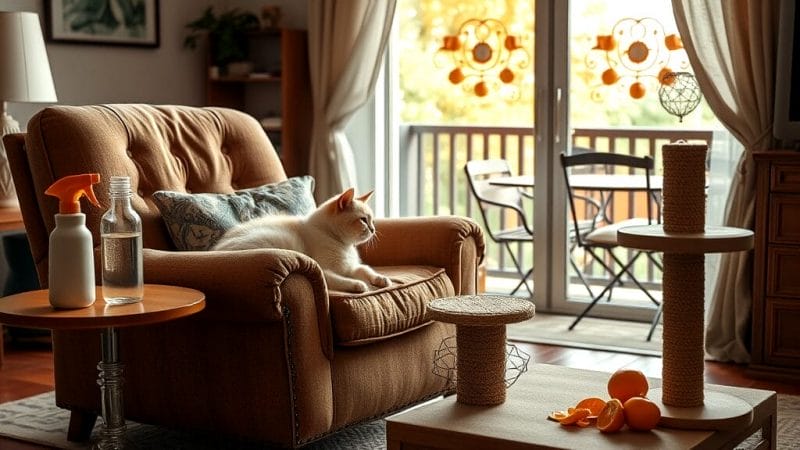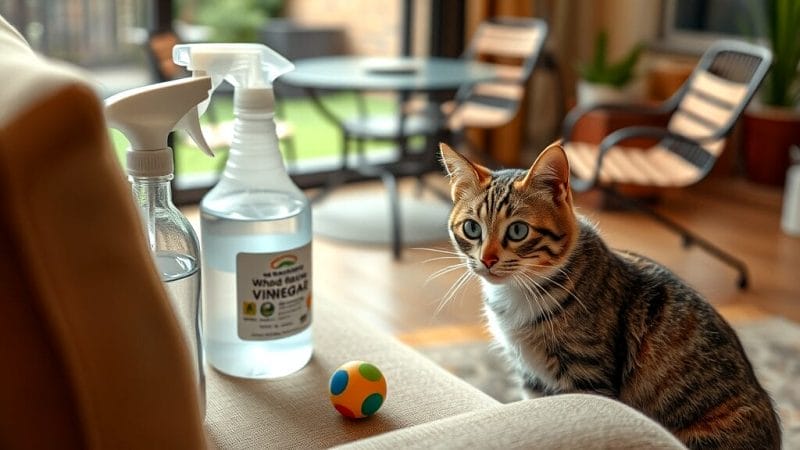Prevent Cats on Furniture: Home Remedy Guide

Have you ever wondered why your cat adores your comfy couch? Cats love cozy spots to nap and perch. But keeping cats off furniture can seem tricky. Fear not! We’ve got some clever tricks up our sleeves. Imagine using white vinegar as a superhero repellent. It’s like kryptonite for cats! Or how about creating a citrus spray? Cats wrinkle their noses at citrus, making it perfect for your sofa! And if you’re feeling crafty, aluminum foil can be your secret weapon. Cats dislike its crinkly texture. Try to train your cat with gentle commands for a more hands-on approach. Remember, consistent training works wonders. So, let’s help our fellow cat owners tackle this furry furniture dilemma.
Why Cats Love Your Furniture: A Cat Behaviour Insight
What is it about your furniture that makes it so irresistible to cats? They’re drawn to comfy, elevated spots. These areas offer warmth and a view of their domain. It’s like a throne for the house’s little kings and queens. Offering alternatives, like cat trees, can help redirect this fascination.
To keep cats off furniture, try using home remedies. Citrus sprays can be useful, as cats find the smell off-putting. A spritz of lemon or orange oil mixed with water can do wonders. But always test on a small section first. Another trick involves aluminum foil. Its texture is unappealing to cats, keeping them away without harm.
For a more interactive approach, consider training. It’s not as tricky as it sounds. You can train your cat to stay off certain areas with patience and consistency. Reward good behavior to encourage them. Many cat owners have found success with this method. And when all else fails, there’s always white vinegar. It’s safe but check for fabric discoloration.

DIY Repellents to Deter Cats from Furniture
Considering DIY methods to deter cats from your favorite couch? Let’s get creative! One cat-tested trick involves aluminum foil. Cats dislike its slippery texture and sound, so lay it on your couch for a no-climb zone.
Need a different approach? Try a homemade citrus spray. Mix lemon oil and water, then spritz it on your furniture. Your cats will find it unpleasant, but your sofa will smell fresh!
For a more hands-on tactic, learn to train your cat. Use firm commands and offer treats when they stay off the couch. It’s a bit like teaching an old dog new tricks, but patience pays off!
Vinegar is another home remedy. Fill a spray bottle with water and white vinegar. Apply it to spots you want to protect. It’s like a force field for your furniture.
Cat owners, remember to provide alternatives like scratching posts. This keeps your kitty entertained and away from your beloved couch.
Homemade Citrus Spray: A Cat Repellent
Crafting a citrus spray is a nifty trick to keep cats away from your furniture. Cats have a strong aversion to citrus scents, making this an effective and natural deterrent. Mix a few drops of lemon or orange oil with water in a spray bottle. Before spraying, test on a small, hidden area to ensure it won’t harm the material.
This home remedy can be your secret weapon to keep those furry paws off your cozy spots. Use it sparingly, though, as too much can overwhelm cats and humans!
Remember, keeping cats at bay isn’t just about making your couch a no-go zone. Providing alternative spaces, like a comfy cat tree, helps. It’s like offering them VIP seating elsewhere.
And don’t forget about your outdoor furniture. A spritz of citrus spray can keep curious kitties from turning your patio into their playground.
Lastly, the humane society encourages positive reinforcement for those who care for animals. So, reward your cats when they show interest in their place, not yours.

Aluminum Foil: A Simple Deterrent
When pondering how to keep cats off furniture home remedy strategies, think of aluminum foil as a clever trick. Cats tend to steer clear of it due to its slippery texture and crinkly sound. Picture this: your fluffy friend jumps up, lands on foil, and quickly hops off, confused by the foreign sensation beneath their paws.
This method can save your couch from unwanted scratches and fur. Place sheets of foil on the areas you want to protect. It’s simple, effective, and won’t cost you much. But don’t forget—cats are clever creatures. They might try to outsmart you!
For added measure, consider pairing this method with other solutions. For instance, a homemade citrus spray can add another layer of deterrence. And if you’re curious about cat training techniques, Basepaws discusses diverse methods in their guide.
Remember, patience is key. Your efforts will help transform your home into a more peaceful space, free from feline furniture invaders.
Training Your Cat: A Humane Approach
Maintaining a respectful relationship with your feline friend is about patience and understanding. Try clever tactics to prevent the little furball from leaping onto your beloved furniture. Start with firm commands and gently remove them, rewarding them with treats when they stay off. It’s like training a tiny lion, minus the safari adventure!
Want a trick straight from the humane society playbook? Introduce them to a comfy cat bed or an enticing scratching post nearby. Redirecting their attention works wonders! If you’re feeling crafty, a spray bottle filled with water and a dash of white vinegar can do the trick. Cats aren’t fans of the smell.
Is your outdoor or patio furniture under siege, too? Keep your peace with homemade deterrents. A sprinkle of citrus or strategically placed aluminum foil can protect your precious seats from unwanted fur. The image credit for this newfound peace of mind? It is a harmonious blend of love, patience, and a few sneaky tricks.
The Role of Vinegar in Keeping Cats Off Furniture
Using vinegar as a deterrent can be quite effective for repelling cats from furniture. Mix white vinegar with water in equal parts and spray it on the spots you want to protect. The potent smell is disliked by cats, keeping them away without harm. Just be careful with fabrics; vinegar might change their color.
Transforming your patio furniture into a no-go zone for felines also works. It’s like waving a red flag to a bull, except it’s a clear, invisible scent warning for cats. But don’t overdo it—test a small spot first.
For indoor spaces, escaping the antics of cats requires creativity. Are vinegar and water spray not cutting it? Try covering your outdoor furniture with furniture covers or using double-sided tape. These methods can save your precious seat from unwanted attention.
Humane Society often suggests non-toxic solutions that balance safety and effectiveness. Think of it as a friendly nudge rather than a harsh push. So go on, give your furry friend some boundaries.

Other Alternatives for Cat Owners: Commercial Products and Furniture Covers
Turning to other choices, commercial repellents can be a lifesaver for those wondering how to keep cats off furniture home remedy methods might not cover. These products are often easy to use, and many pet stores stock them. However, always check labels for safety.
Furniture covers act as shields, protecting your beloved couch from curious paws. Consider selecting durable materials that resist scratches and are easy to clean. Double-sided tape can also be a game-changer, creating an unpleasant texture that deters scratching and climbing.
Filling your space with scratching posts and engaging toys also helps direct your pet’s energy. It’s like offering a playground away from your cherished sofa.
